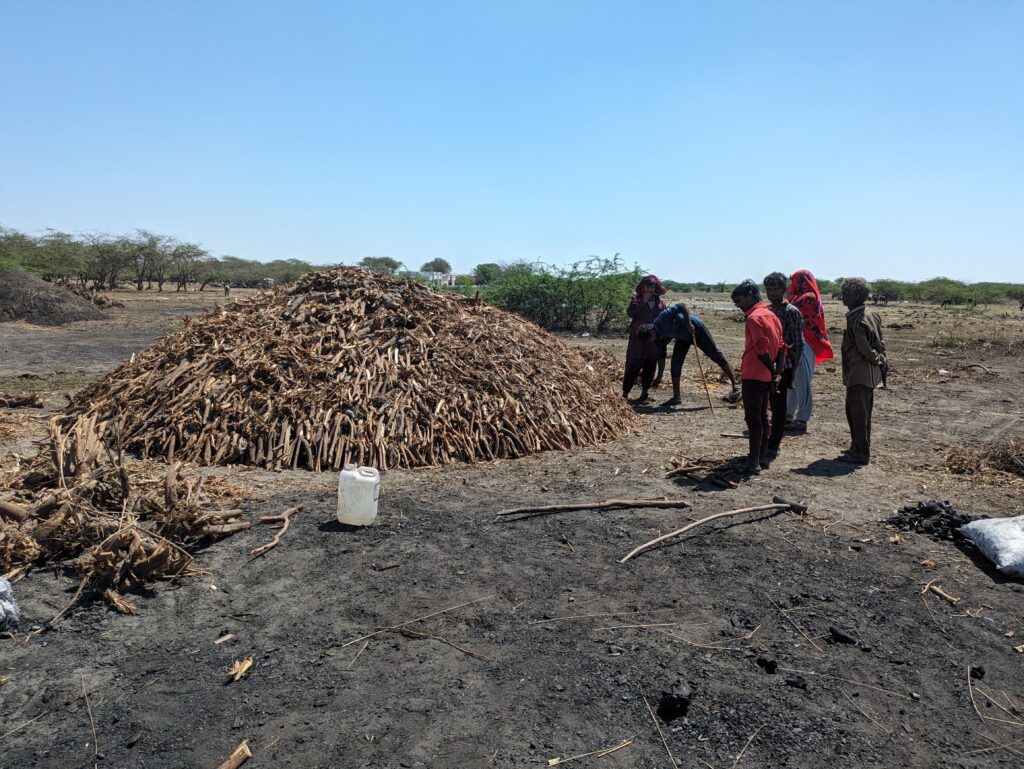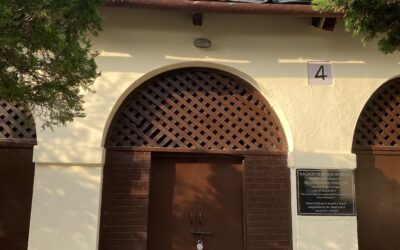In my previous blog, I briefly introduced how the invasive prosopis juliflora came to be in Kachchh. With the intention of vegetating wastelands and halting desertification. As a result, prosopis, also known as the “mad tree” gradually spread across a significant portion of the Kachchh region. In this blog, we’ll have a brief look at how these factors are connected with the charcoal industry in Banni. As well as the socio-economic conditions surrounding it.
The Process
While prosopis did halt desertification, it also brought unintended consequences. Such as reduced grazing areas for cattle, groundwater depletion, and a decline in native flora and fauna. However, a new industry emerged as a silver lining: charcoal production from the woody biomass of prosopis. This meant new livelihoods for the people, and their earnings increased significantly. People started earning from selling the wood directly, making charcoal from it. Some were also selling honey from the bees which get attracted to these trees. Let’s have a closer look at the charcoal value chain.
Here’s how the process unfolds:- labourers chop and collect wood from the forests. Then deliver it to a designated plot. Another group of labourers at the plot arranges the wood into mounds, covering them with gunny sacks and mud. A fire is ignited through a small hole on the top and burns for several days. Continuous monitoring is crucial as the mound settles unevenly, requiring additions of wood and mud. Workers open the completed mound to reveal charcoal, which they gather into sacks weighing approximately 40kg each, a traditional unit known as a mann. They sell these sacks to owners who transport the charcoal to various parts of the country, including Morbi, for quality sorting and distribution to places like Ahmedabad and Delhi. There, factories and restaurants use the charcoal as fuel. In a many cases, women stick to filling the gunny sacks after the production.

The Economics
Economically, the labourers who actually do all the hard work of making the charcoal earn the lowest, often below the minimum wage. The trader earns the highest, as is the case in most other industries. Since the standard is 1 mann of gunny sack which is around 40 kgs, we’ll calculate cost associated with the same. For the raw materials, we need around ₹300 of raw wood (which is 5 mann since approx 5kg of wood is required to produce 1 kg of charcoal).
Gunny sacks cost around ₹40 for coating the mound. Next for the labour cost, ₹100 goes into it for the charcoal production. This brings the total to ₹440. The next cost comes during the transportation, when ₹10-20 goes to the authorities for allowing the trucks to leave the region. The trader buys it for ₹500 and sells it for around ₹800 to the end clients. The price shoots up just before the monsoon, as production halts due to the rains and the clients keep enough stock beforehand. Charcoal weight also reduces over time if kept unused in storage, and the quality completely degrades if mistakenly left open under the sun or in the rain.
Hussain *, a former charcoal producer, noted a decline of over 70% in charcoal production from its peak. He attributes this decline to shifting livelihoods such as tourism and handicrafts, offering better benefits with fewer downsides than charcoal production. Additionally, the quality of wood required for charcoal has diminished over time
In the past, many communities engaged in woodcutting and charcoal production. This has slowly changed with the onset of tourism, handicrafts and textiles. These offer better benefits in terms both economically and socially. Nowadays, the labour work of the charcoal production is largely limited to the Vada Kolis. They are the semi-nomadic community of the Kutch region, and they are a minority group in the landscape. Their current livelihood is selling the prosopis wood, resin collection, woodwork, and gathering honey from prosopis trees. You can read more about them here.

Risks
Charcoal production carries significant risks. Labourers often suffer burns while opening the mounds, and the black smoke poses severe risks to their lungs. The sleepless nights required for monitoring the burning process also contribute to various health issues. Rare cases of death have also occurred during the monitoring of kilns. When a large mound needs to be filled with either mud or wood, labourers have to climb up a ladder to ensure this. In one instance, a slip of the leg during that process proved fatal.
Banni prohibits agriculture and industries as it is a protected reserve forest. Despite woodcutting being illegal since 2008, enforcement by the forest department is lax due to heavy community dependence on prosopis for livelihoods. Wood and charcoal transportation often occurs at night to avoid attention, occasionally involving under-the-table dealings with forest officials if caught. Since this has been the way of life for almost forever (barring the period between 2004-2008 where charcoal was legalised), the community is used to it. When I was researching on this, the labourers and owners were hesitant to tell me things about it. Some said “dhandha bandh karvaake rahoge” (“you’ll stop our business”). However, the ban doesn’t affect the community much, as the enforcement is lenient.
Charcoal Vs Biochar
Charcoal production has seen a significant decline, as people are exploring other livelihood options like tourism, handicrafts, and pastoral-based products which is more viable and better income generating alternate. The production process also causes air pollution, which can lead to respiratory problems, and releases greenhouse gases (GHGs) like CO2 and methane, contributing to global warming.
A better alternative has emerged with the development of carbon markets in the form of biochar. Creating biochar-based carbon credits has proven to be better economically and health-wise, as labourers don’t have to stay awake all night for monitoring, and it also has significantly lower emissions than charcoal. The Kon-Tiki Kiln is a cone-shaped container made of steel for the production of biochar, and its conical shape ensures even heating and efficient pyrolysis. The production doesn’t require highly skilled people or high-tech machinery. It is a good source of livelihood and supports the self-sustenance of the community.
Unlike traditional charcoal production, which requires continuous monitoring day and night, biochar can be produced in two five-hour batches in a day. where one kiln can earn the labourers around ₹500, which is the rate decided. Biochar based credits usually fetch around ₹8-12/kg of production as per the current rates that are going on in the market. Unlike charcoal, which requires thicker, high-quality wood, biochar with any quality of wood facilitates long-term carbon storage, positively contributing to climate change mitigation as the carbon dioxide which was supposed to go to the atmosphere has supposedly been sequestrated permanently. Additionally, adding biochar to land can improve the soil quality by helping in retention of water and nutrients because of its porous nature, high surface area, and helping in pH regulation.
*Name changed to maintain confidentiality




0 Comments